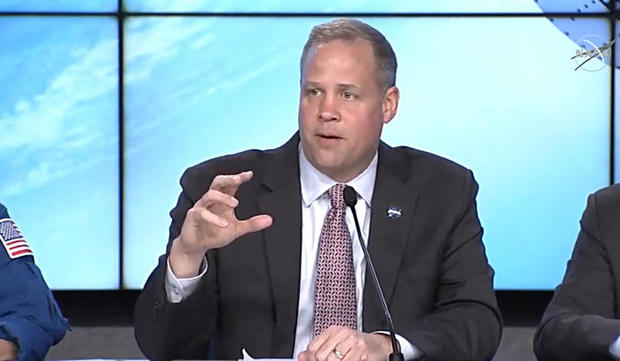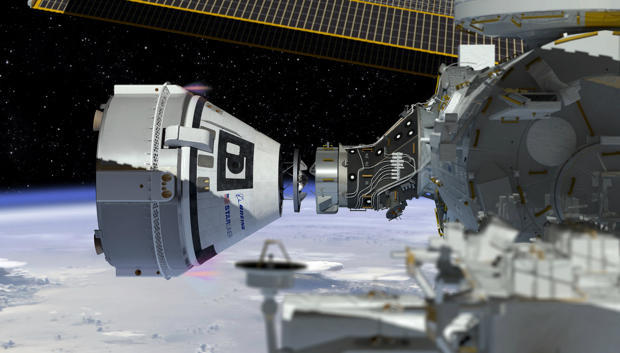A United Launch Alliance Atlas 5 rocket boosted a Boeing Starliner capsule into orbit Friday for a long-awaited unpiloted test flight, but an on-board timing glitch prevented a thruster firing needed to set up a rendezvous with the International Space Station. Due to the problems, the Starliner will not dock with the space station as scheduled and will make an early return to Earth.
Flight controllers uplinked commands to, in effect, manually fire the thrusters, but the instructions never got through. The spacecraft was switching from one NASA communications satellite to another and because of the initial glitch, it was unable to lock on.
“The moment when we needed to talk to the spacecraft, it couldn’t hear us,” NASA Administrator Jim Bridenstine said in an interview with CBS News. “It looks like the the spacecraft was rotating or maneuvering in a way that the antennas could not make lock with the satellite.”
Trending News
Flight controllers later were able to uplink commands to boost the Starliner into a stable orbit. But because of the missed rocket firing, and propellant wasted by smaller maneuvering jets, the control team ruled out an attempt to rendezvous with the space station.
Instead, the team focused on identifying what engineering tests could still be carried out while making sure the spacecraft preserves enough propellant to allow a safe de-orbit rocket firing and landing Sunday at Boeing’s White Sands Missile Range recovery site in New Mexico.
Bridenstine said engineers expect to complete many of the test flight’s original objectives despite the mission’s less-than-stellar start. Even so, “we’re disappointed,” he said. “Make no mistake, this is not the outcome we were hoping for.”
“There’s still a lot of things that we’re going to get out of this test,” he added. “We (now) know that the Atlas 5 rocket can launch a Starliner. … The Starliner is now receiving commands and it is operating as advertised in orbit around the Earth.
“So we’re going to be able to continue testing all of these capabilities. Plus, we’re going to do entry, descent and landing. All of that needs to be tested ahead of time. So it is true the optics aren’t good, we are in fact disappointed, but there’s still a lot of good that can come from it.”
Regardless of the details, the Starliner’s maiden voyage did not get off to the successful start Boeing managers were hoping for in the wake of the company’s devastating 737 Max aircraft disasters and the recent decision to shut down its 737 Max assembly line.
The test flight began when the workhorse Atlas 5’s Russian-built RD-180 first stage engine fired up at 6:36 a.m. EST, followed by ignition of two solid-propellant strap-on boosters. The 172-foot-tall rocket then vaulted away from pad 41 at the Cape Canaveral Air Force Station atop nearly 1.6 million pounds of thrust.
Lighting up the pre-dawn sky with a brilliant jet of white-hot exhaust, the Atlas 5 quickly arced away to the northeast, putting on a spectacular morning sky show for spaceport workers, tourists and area residents along Florida’s “Space Coast.”
The Atlas 5’s dual-engine Centaur second stage completed the launch phase of the mission in flawless fashion, releasing the Starliner capsule into an initially unstable orbit with a low point deep in the atmosphere.
That was by design. The Starliner launch trajectory is intended to ease the stress on the spacecraft — and, eventually, crews — in the event of a high-altitude launch abort.
But the so-called “flat” trajectory requires the Starliner’s built-in thrusters to fire about 15 minutes after release from the Centaur stage to raise the low point of the orbit, putting the craft in a stable orbit and on course for rendezvous with the space station.
But telemetry from the Starliner showed an internal timer was not in synch with the actual time and as a result, the orbit insertion rocket firing was not carried out. Flight controllers at the Johnson Space Center, acting in a backup capacity, then radioed up commands to fire the rockets as required.
“The backup procedure is to send a command so that it will do the orbital injection burn the way it’s supposed to do it,” Bridenstine said. “The spacecraft was going from one satellite to the next. In this particular case, it didn’t make lock on the next satellite, so we couldn’t get the command to the capsule.”
Boeing and SpaceX are both building commercial spacecraft to carry astronauts to and from the International Space Station, ending NASA’s sole reliance on Russian Soyuz vehicles. SpaceX launched its Crew Dragon capsule on a successful unpiloted flight to the station in March and Boeing planned to follow suit with the Starliner mission this week.
Following the Starliner mishap, SpaceX CEO Elon Musk tweeted: “Orbit is hard. Best wishes for landing & swift recovery to next mission.”
Going into Friday’s launch, both companies were planning to carry out initial piloted test flights to the lab complex in the next several months, ending a hiatus in U.S. human space launch that began with the shuttle’s final flight in 2011.
“We’re moving into a new era, we are going to launch American astronauts on American rockets from American soil for the first time since the retirement of the shuttle, and we’re going to do that in the first part of next year year,” Bridenstine said Thursday.
“But we’re doing it in a way that never been done before. This time, we’re going to go with commercial partners. NASA is done purchasing, owning and operating the hardware. We’re buying a service, the goal being that NASA wants to be one customer of many customers in a very robust commercial marketplace for human spaceflight.”
How this week’s Starliner flight might affect Boeing’s plans for a piloted mission is not yet known.
Since the space shuttle’s retirement in 2011, NASA has been forced to buy seats aboard Soyuz spacecraft to ferry U.S. and partner astronauts to and from the International Space Station. Seats on recent missions have cost more than $80 million each and since 2006, NASA has spent $3.9 billion for 70 Soyuz “tickets.”
In 2014, after a series of competitions, NASA announced that Boeing and SpaceX would share $6.8 billion to develop independent space taxis, the first new U.S. crewed spacecraft since the 1970s.
Under a $2.6 billion contract, SpaceX is building a crewed version of its Dragon cargo ship that will ride into orbit atop the company’s Falcon 9 rocket. Boeing’s Starliner is being developed under a $4.2 billion contract and will rely on the Atlas 5 for launch.
NASA originally expected the new spacecraft to fly in 2017, but both companies have been delayed by funding shortfalls in Congress and by a series of technical issues, including trouble with parachutes and emergency abort systems.
Those delays forced NASA to buy additional Soyuz seats, at a cost of about $1 billion, to ensure an uninterrupted U.S. presence on the space station, according to the agency’s inspector general.
After a successful unpiloted flight to the space station in March, SpaceX suffered a major setback in April when that same Crew Dragon capsule was destroyed during a ground test. The California rocket builder has recovered from that incident and is preparing for a dramatic in-flight abort test in early January.
If that test goes well, SpaceX will press ahead for launch of a Crew Dragon carrying two NASA astronauts — Douglas Hurley and Robert Behnken — on a piloted test flight to clear the way for operational crew rotation missions.
In a similar fashion, Boeing’s unpiloted test flight this week marked one of the company’s final major hurdles before it would be clear to launch a piloted flight with company Vice President Chris Ferguson and NASA astronauts Mike Fincke and Nicole Mann.
Going into Friday’s launch, it was not known which company would get a crew into orbit first, but SpaceX already appeared to have the edge because the Atlas 5 has multiple launches on its early 2020 manifest, including a high-priority science mission in February followed by two military flights in March and April.
SpaceX operates two launch pads in Florida, giving it more scheduling flexibility. But multiple reviews will be required before either company is cleared to carry astronauts, and no launch date decisions have been made.
But NASA needs one or both companies to fly soon. The Russians will only launch two Soyuz missions to the station per year starting in 2020, limiting the space station crew to three — two Russian cosmonauts and one NASA astronaut — until Boeing or SpaceX can begin operational crew rotation flights.



